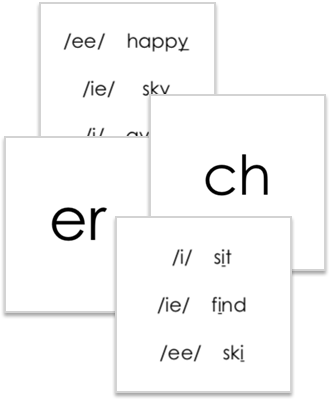The overview on the previous page explained the linguistic reasoning behind the method. This page goes over the preparation needed to use it.
Multisyllable Decoding Made Easy
With proper preparation, a young child can be taught to decode the vast majority of multisyllable words within his listening vocabulary by applying just one rule and learning three exceptions to the rule.
The Main Rule is:
Stop each chunk after the vowel sound and try the First Vowel Sound.
The Three Exceptions are:
- Add the next sound to the chunk if it is a doubled consonant.
- Add the next sound to the chunk if it is a marker.
- Add the next sound to the chunk if the following chunk is “hard to say“.
Preparation for Using the Main Rule and Three Exceptions
It has been my experience that second graders can easily learn to apply the main rule and then to apply the exceptions, if one occurs. As they learn the procedure, their confidence in their ability to decode longer words grows while their tendency to guess at them diminishes.
Note, though, that I emphasized with proper preparation. Following are the steps required to ensure that your child is prepared.
Step 1: Explain Vowel Sounds
Your child should be comfortable with the concept of a vowel sound. That's something that you can easily deal with, if you haven't already, by working through the page What Are Vowel Sounds?
Once your child understands the concept of a vowel sound, and also knows what the First Vowel Sounds are, the next step is to become comfortable with the entire range of vowel sounds and their spellings.
Step 2: Discuss the Structure of English Vowel Sounds
The best way to introduce the rest of the vowel sounds is to simply administer the Code Knowledge Test. To do so, if you haven't already, download both the Code Knowledge Sheet and the Test Scoresheet below.
Then, administer the test, prompting for as many of the various options as your child can recite. This will give you a feel for how comfortable your child is with the English phonics code. The page Testing Code Knowledge goes over the details of administering the test.
If you're satisfied that it won't be necessary to use the Advanced Code Phonics Workbook to build your child's code knowledge up, then you should next go over the Test Scoresheet, showing your child the various pronunciation options for each letter or digraph, numbering each option
Example #1
For example, take the vowel letter o. The examples are "mop/cold/to" so establish that the sounds of the letter o are /o/oe/oo/ and point out that the First Vowel Sound is /o/ (hot), the Second Vowel Sound is /oe/ (cold), and the Third Vowel Sound is /oo/ (to). Then make sure he realizes that the Second Vowel Sound of all five of the vowel letters is just the letter name. Go over any Third and Fourth Vowel Sounds quickly; your child will easily learn them during the multisyllable lessons.
Example #2
Now look at the answers for, say, the digraph ar. The examples are "car/war/dollar/arid" so establish that the sounds of the digraph ar are /ar/or/er/err/ and tell your child that he should always try the /ar/ sound first in an unfamiliar word, and that if /ar/ doesn't work, one of the other sounds usually will, so he eventually has to learn all of the options.
Code Knowledge Resource
Go over a few more of the items on the Test Scoresheet, and return to it occasionally for review. Again, the multisyllable lessons themselves provide excellent review of the various pronunciation options. The important thing is that your child have a good grasp of the First and Second options, and sometimes the Third or Fourth, for most of the vowel spellings.
Note: If your child learns the content of all 84 flashcards included in our free downloadable set below, he will have an excellent grasp of the Advanced Code
Download the OnTrack Reading Phonogram Flashcards

Step 3: Review the Concept of Doubled Consonants
According to information generously provided to me by a reader, Dr. Earl Eugene Roth, Jr., the doubling of consonants was a concept originated by a scribe named Orm in about 1180 AD as a diacritical marking to indicate that the preceding vowel sound was a short vowel sound. (He passed this along to me after reading about the multisyllable method I was using.) In other words, Orm actually created the basis for the First Exception. (Webster then complicated the matter, by splitting one sound into two when he devised his syllable structure.)
To ensure that your child understands the concept, go through the worksheets from the three Phonics Tidbits pages below, in order.
Explaining Split Vowel Spellings
Adding Suffixes to Split Vowels
Then, for good measure, do the worksheet on the page Reading the Suffix ed also in the Phonics Tidbits section.
Step 4: Explain the Four Markers
The Second Exception involves the markers, x, ck, tch, and dg. They are called markers because, like doubled consonants, they reliably mark the vowel sound preceding them as a First Vowel Sound (the short sound).
The next page, First Vowel Sound Markers, has a more thorough explanation along with a worksheet to practice the concept. After that, your child should be ready to tackle the multisyllable work that follows that page.
